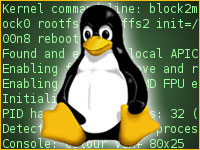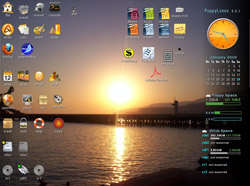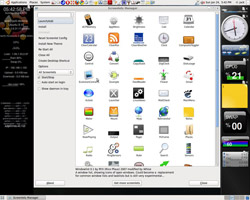
Screenlets bring a collection of fun things and useful apps to addfunctional eye candy to the Linux desktop with little or no resourcedrain on the computer.

Windows and Mac machines have their widgets. Linux has its Screenlets.So you can scratch one more reason from the list of why you shouldn’tmigrate to an open source operating system.
When I held newbie status as a newcomer to the Linux OS, I had littleinterest in or use for Screenlets. However, back then I was struggling tomaster the basics of the open source world of computing. Now, though,Screenlets have become an integral part of my computing finesse.
Screenlets are smallapplications that reside on the desktop. They are not icons to run aprogram; they ARE the program. These apps are much like electronicPost-Its stuck on the screen. Each one does its own thing.
For example, on my Puppy Linux and Ubuntu Linux computers, I haveScreenlets stacked vertically along the right edge of the desktop screen. One Screenlet shows me an analog clock with a sweeping secondhand. The clock’s settings allow me to create a series of reminderalarms. Below that is a monthly calendar.
A series of sensors and system monitors completes the stack ofScreenlets. Depending on which desktop or laptop is at hand, theseScreenlets vary with wireless signal strength indicators, CPUperformance, RAM consumed, remaining battery power and a glimpse ofhard drive and thumb drive free space left.
Configure Aplenty
It’s easy to configure the Screenlets, so you can adopt them to yourown computing habits. Convenience is the rule.
For example, you can configure different profiles to run differentsets of Screenlets.
I use a different arrangement. I set different Screenlets on each ofthe four virtual desktops on my various computers. This lets you runseparate sets of widgets and applications on their own desktopswithout minimizing windows or clicking the Show Desktop icon. I resizethe windows of running applications so they do not cover theScreenlets running on the edges of the screen.
Either way, the Screenlets always run. For me, this is far better thanscrolling through menus or clearing the desktop to click an icon tostart a program.
I even have my netbook computer configured so my Screenlets arevisible despite the much smaller display space. I can right click onthe top of each Screenlet to adjust its size and other properties tosqueeze into the available space.
Treats Galore
Screenlets range from very useful system sensors to fun and games. Youcan watch CPU, memory, Internet traffic and much more while you workor play on the computer.
The entertainment potential is endless with Screenlets. Internetradio, audio collections and favorite videos are always a glanceaway. Set up one or more picture frame Screenlets to display acollection of photos.
One of my favorite Screenlets keeps an open sticky note visible so Ican instantly click the tiny yellow page and leave a reminder note. IfI need multiple reminders, I can run numerous copies of the Screenlet.
Getting Screenlets
Screenlets take up very little in the resources department. Plus, theyblend into the desktop nicely. Screenlets are almost as numerous asiPhone apps. So whatever special interest you have, there is probablya Screenlet someplace for it. Just use your favorite search engine toscour the Internet.
As a starting point, look in your Linux distro’s package manager. Thebeauty of using your distro’s package manager to get and installScreenlets is that the process involved is hands-off. It is always easierto do these procedures automatically.
If your flavor of Linux does not include a ready-made Screenletinstallation package, then roll up your sleeves. You still have a feweasy options. Check out other package systems. You might see themlisted in the Systems or Administration menu. Or you might have tofind them in the package manager and download these other softwarerepositories (software storage centers on the Internet).
Look for one of these: Synaptic Package Manager, Adept Manager, DebianPackage Viewer, Smart Package Manager. These software managers willlet you click on the software package you want — presumably theScreenlets — and automatically install them.
More Options
Another option to getting Screenlets installed on your system is to goto the home of the Screenlets Organization here. Once you have theScreenlets engine up and running, you can return for more Screenletshere.
Another option is to get what you need at Launchpad.net. Go here for the downloadssection.
A final place to look for screenlets is the Gnome Desktop Screenletsproject at Gnome-look.org.
Off-Channel Sources
If your Linux distro’s package manager does not include the Screenletspackage, you might still find it on the developer’s Web site. Someopen source developers prepare packages for specific Linux distros.Read the files listed for download on the Web site. Often, you willsee a Screenlet that matches your particular OS.
If you find the file matching your OS, download it. Your system’spackage manager will automatically install the software when you clickon the file name.
If not, you will have to get the Screenlets package and install it theold-fashioned way. Manual package installation can be very dauntingfor Linux newbees. In this case, look for the compressed package thatyour system uses.
Bizarre Binaries
If all else fails, you will have to work with the compressed version.For any Linux OS system, download the .tar.gz. Any file that has “.tar”near the end of its name is a compressed file. This type of file iscalled a “tarball.”
To uncompress the tarball and get it ready for installation on yourLinux system, open a terminal window in the same directory as thedownloaded file. Then enter this command exactly as it appears here:
tar -xzf filename.tar.gz
(Note: put the exact filename you downloaded in place of “filename”but do not use the quotation marks. And remember, with Linux, the case ofthe letters DOES matter!)
When the processing is finished, you will see this prompt: []. Nowenter this command:
python setup.py install
Screenlets are written in the Python programming language; this lastcommand tells the OS how to complete the installation.
When the installation is completed, close the terminal window. If youdo not see a menu entry for Screenlets, open another terminal windowand enter this command to start the Screenlets engine:
Run screenlets-manager
For specific installation instructions for some of the most populardistros, see the directions here.
Compiz Options
If your system runs the Compiz video enhancement feature, you willhave extra-special eye candy. These additional options make usingScreenlets even better. For instance, you can toggle Screenletson and off. To do this, though, you need the latest widget plug-in forCompiz-Fusion installed.
For help with the settings, go to the Compiz forum here.
You can adjust the settings yourself. Go to the Compiz SettingsManager (System>Parameters>Advanced Desktop Effects Settings) inthe General Options menu and uncheck “Hide all windows” and “Skiptaskbar windows.”
There is no end to the fun and functionality that go with usingScreenlets. The eye candy factor alone adds to the flexibility ofdesigning unique desktop views.
Think of Screenlets as the ultimate desktop display — they’re widgets gone wild!





















































